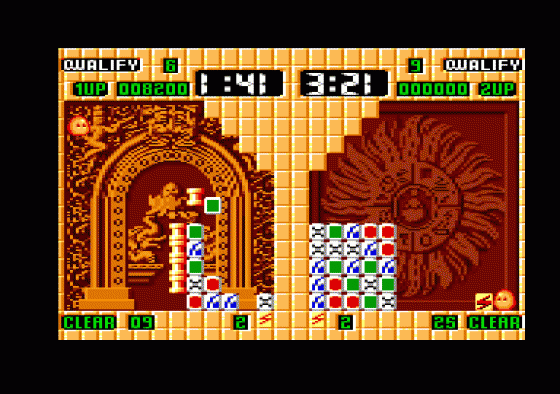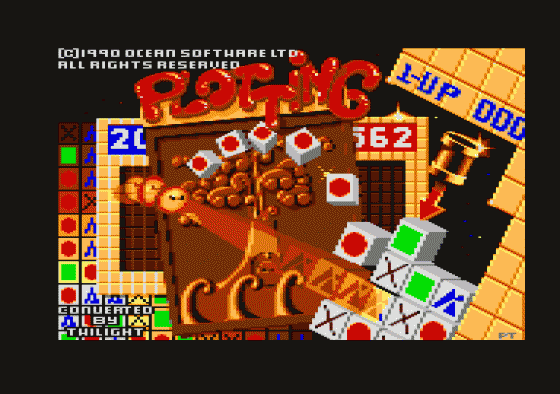
Amstrad Action
 1st October 1991
1st October 1991
Categories: Review: Software
Author: Adam Waring
Publisher: Ocean
Machine: Amstrad CPC464+/GX4000
Published in Amstrad Action #73
Plotting
Puzzle games, eh? Can't get enough of the things, can you? Well you can, actually. Plotting is yet another in a long line of generic releases of games that combine brain power along with joystick power. It all started with Tetris in the late '80s. But that was then, this is now...
For a game called Plotting, it doesn't have much of one. You play a little round blob who fires blocks at another pile of blocks. The idea is to reduce this pile - which happens when two like blocks collide. Get rid of enough and you're through to the next round.
Your character stands at the left hand side of the screen, with the pile of blocks on the right (reversed if you're player two). If you had hands, you'd be carrying a block in them. As it is, one hovers at your side. Line yourself up with a matching block, press Fire, and it shoots away, absorbing the matching block. You can fire at the blocks horizontally, or hit them from above by bouncing them off walls. (When bouncing a block off a wall, an arrow indicates which one it will end up hitting.)

Actually, what happens when the blocks collide is a bit weird. The matching block that you hit disappears. The next block along is replaced by the block you fired. The block that's replaced flies over to you. so you have something to fire on your next go. Should there be a row of the same kind of blocks, then the whole lot will disappear. Clear as mud, eh? Better take a butchers at the box that explains it more clearly, then!
But it is complicated. Even when you've read and understood the rules, there are still situations where you're not sure exactly what's going to happen. True, you can sit down with the instructions and work out every move, but can you be bothered with all that?
There are four different types of blocks, all colour coded and with different symbols - so you can't claim to have lost because you got them mixed up. These are seemingly randomly stacked at the start of each game, but in fact are set to the same pattern each time you load. This means, presumably, that the best method to complete each screen can be worked out and adhered to. (The starting patterns are different for the two players, though, so you can choose to be 'player two' for variety.)

A pre-determined number of blocks need to be eliminated before you can go on to the next screen. To be honest, there's not a lot of difference between levels, apart from the pattern of walls and pipes that serve to deflect the blocks as you fire them.
The walls always keep to the top corner of the screen, and the varying pattern prescribes which columns of blocks can be hit from above. Pipes have a virtually identical role to walls, apart from the fact that blocks can pass through them on their downwards path. When hit from the side, the blocks bounce off at an angle.
You're given three lives at the start of a game. These are lost when there are no matching blocks to hit - a situation that is automatically calculated by the computer. Should this occur, then you're give a 'zapper' block, which is capable of taking out any other type. Extra 'zappers' can be found amidst the pile of blocks. Hit one of these and you're given another life (Hurrah!).

More drastic than losing a life is running out of time. In this situation, all remaining lives are forfeited. It shouldn't happen unless you get really tired of the game (or you're really crap), though - to say the time limits are rather generous is a bit of an understatement.
The basics of the game are very simple, but have been prettied up with cutesy graphics. The little character is a sort of furry blob with eyes. The blocks look rather like the ones used in Puzznic. In fact, they're identical, and indeed the arcade machine the game is derived from comes from the same manufacturer, Taito. The backdrops change every couple of levels. These are rather basic, and merely serve as something to play against; they have no function in the gameplay. By any standards, the graphics are excellent. They don't really need to be for this sort of game, but they are.
A tune plays continuously throughout the game. It's very nicely done, and not that annoying - even after some time. There's very little in the way of spot effects, but, then again, there's little variety in the things that happen in the game.
The trick is to anticipate what will happen when you fire off your blocks. Only by working out the consequences of your actions will you avoid losing all your lives in the first two minutes.
And that's where the problems lie - you have to spend far too much time thinking about what's going to happen, rather than actually playing the game.
This is not a problem in such games as Puzznic, where there are definite puzzles to solve. But this game lacks the excitement of beating the brain-teasers against the clock. The time limit isn't at all tight, and there's just not enough action.
First Day Target Score
Work out what's going on.
Second Opinion
It looks terrific, but once you get to grips with the gameplay (if you ever do!) it starts getting decidedly dull. The time limits are too long and the rules too hard to grasp.
Verdict
Graphics 92%
Beautiful graphics that could be mistake for the arcade machine's.
Sonics 85%
Frantic tune that's not too infuriating.
Grab Factor 81%
You get sucked in by the polish and instant playability.
Staying Power 70%
Will it keep you interested? Maybe, maybe not.
Overall 75%
Plenty of playability, but not as compelling as other puzzle games.






